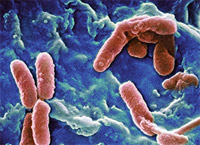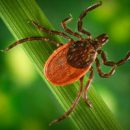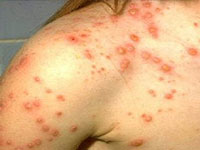What is - a blue chopstick? How does the sinic chopstick spread? What infections it can cause? Answers you will find in this article.
Content
Characteristic of the blue chopstick
Pseudomonas Aeruginosa is a gram-negative moving bacterium of a row-shaped. Refers to the genus Pseudomonas (with more than 140 types of bacteria) Family Pseudomonadaceae (Pseudomonada). Known also called «Singny stick».

Widespread in nature: It is found in the soil, in water, on plants, in the gastrointestinal
Man and animal tract. May occur both in a biofilm attached to any surface or substance and in plankton form, t.E. in the form of a separate bacteria moving through its polar flagery. Moreover, the sinic stick is one of the most moving microorganisms observed in water samples from natural sources. Capably not only for a long time to persist in the environment (wet atmosphere or water), but also successfully multiply. The optimal temperature for the development of 37 degrees, but can grow at 42 degrees.
Extremely stable to most antibiotics at the expense of a barrier created by liposaccharides
The external membrane, as well as the frequent presence in the thickness of the biofilm, which also performs a protective role.
There are strains for which any of the famous antibiotics. What
Concerns disinfectants, the sytensitous wand is sensitive to 0.5% chlorine solution, 3% hydrogen peroxide solution 2% phenol solution (carbolic acid).
The cinema wand is one of the causes of the headache of the pools, as it can colonize the tile surface, clogging into the seams and forming a protective biofilm, which is why standard disinfectants do not affect it.
Diseases caused by a blue rod
Sinnaya wand (Pseudomonas Aeruginosa) is known to microbiologists as a pathogen of plants, however, can cause diseases and people. Strictly speaking, a sinic wand is for a man with a conditional pathogenic organism. T.E. able to cause disease only with a decrease in human immunity. She never amazes healthy intact fabrics. On the other hand, there are no such tissues in the body, which in case of damage or other reduction of protective functions, could not be subjected to the attack of the blue. Therefore, infections caused by a blue rod are quite common hospital infections.
Local infection most often occurs on the site of the cuts (including operating seams) and
burns. The cinema wand may cause urinary tract infection (entered, for example, when
The introduction of catheters), eye infection (as a result of injury or operational intervention), skin infection and soft tissues (wound infections, dermatitis, pyodermia). Often, the blue helen is discovered when examining children suffering from otitis - inflammation of the middle ear. It can be attributed to other serious infections caused by a pneumonia, endocarditis (heart valves infection), infections of the central nervous system (meningitis and brain abscess), a musculoskeletal apparatus (in T.C. joints) and gastrointestinal tract. Unfortunately, local infection very often develops in sometimes fatal bacteremia (general infection of the body associated with the penetration of bacteria in blood).
The infection of the blue rod occurs in three stages: 1) attaching bacteria and colonization
(reproduction) 2) Local penetration of bacteria in fabric, the occurrence of local infection 3) total infection (the spread of infection throughout the body - bacteremia).
The pathogenic effect mechanism of the blue stick is to combine two factors:
Invasive (penetration into damaged tissues) and toxygenic (the allocation of biologically active
products - toxins).
Ways of transmission of a siny stick
As mentioned, the microorganisms of the Pseudomonad family (Pseudomonadaceae),
Including and a cinema stick (Pseudomonas Aeruginosa) are common in the soil, in water, on the surface of plants. They may also be present on the skin, in the nasopharynk and in the intestine of a healthy person (are detected by about 3-5%), without causing disease.
The greatest distribution of infection caused by a blue rod was obtained in conditions
Stationary medical institutions (from here and their name - hospital infections), by virtue of high
Purchases of people with a weakened immunity. In hospitals, a cynical wand is often transferred with
infected with food or water, as well as through the bathrooms, sinks, handles of water cranes, items,
especially wet (for example, towels), which can jointly enjoy the patients,
direct contact with the bacteria carrier or indirectly, through the hands of medical personnel and T.NS.









